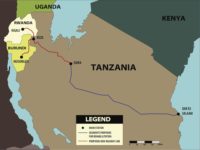Delayed construction of a 1,120-kilometer-long, $4.5-billion crude-oil pipeline in East Africa changed course when Uganda proposed a second, 1,410-km-long, $4-billion route through Tanzania to the Indian Ocean—abandoning the original agreement to go through Kenya.
The original agreement between Kenya and Uganda was to construct a pipeline to transport crude oil from Hoima in Uganda’s Lake Albert region through Lokichar, Kenya—where Tullow Oil Plc, London, discovered an estimated recoverable 600 million barrels—and terminating at Lamu Port, which is under construction to expand capacity.
At a Northern Corridor Integration Projects (NCIP) summit in Kampala, Kenya President Uhuru Kenyatta and Uganda President Yoweri Museveni announced that the two countries now will construct two separate pipelines to transport crude from the neighboring East African states to the Indian Ocean ports of Tanga and Lamu.
The Kenyan line, known as the northern crude pipeline route, will run from Lokichar, located in the northern part of the country, through Kenya to Lamu. No construction scheduled has been announced.
“Kenya was in a better position to construct an export pipeline on its own when the oil price was around $100 per barrel,” wrote Luke Patey, a research associate at the Oxford Institute for Energy Studies, in an October white paper. “The fall in prices since 2014 has made this possibility highly unreasonable, particularly if bearish price forecasts for the coming years prove correct.”
In a joint statement at the NCIP summit, the East African presidents noted, “The summit agreed that two crude-oil pipelines, one from Lokichar [in Kenya’s new oil fields] to Lamu and another from Hoima [in Uganda] to Tanga [in Tanzania], will be developed by Kenya and Uganda, respectively.”
“There is no more paralysis on that matter. We are moving," Museveni stated separately at the summit.
Japan’s Toyota Tsusho did a feasibility study on the 1,120-km Hoima-Lokichar-Lamu crude pipeline and noted in a project brief that the Kenyan side of the pipeline—responsible for much of the distance of the route, the terminal at Lamu, and other supporting infrastructure—makes up $3.2 billion of the total $4.5-billion cost. The project brief says the pipeline would have seven pumping stations and a 300,000-barrel-per-day capacity, with an additional 130,000 bpd in a high-flow scenario.
Toyota Tsusho proposed heating the pipeline to above 40 degrees centigrade to avert solidifying of the crude oil because of its waxy properties. If constructed as first planned, the pipeline would become the world’s longest heated pipeline. Toyota Tsusho also proposed a tariff fee of up to $15 a barrel.
France’s Total S.A. is responsible for the 1,410-km Hoima-Tanga pipeline feasibility study but hasn’t announced tariffs.
Fred Kabagambe-Kaliisa, permanent secretary in Uganda's ministry of energy, in a public statement in April said constructing a crude pipeline through Tanzania, instead of Kenya, “will result in the lowest unit transportation cost and constitutes the most viable option for the pipeline project. If we are able to get a least-cost pipeline to Tanga, then our crude oil will be exported cheaply.”
Three international oil companies developing Uganda’s crude in the Lake Albert area have signed a memorandum of understanding with Uganda for the commercialization of the hydrocarbons through crude to power, refining and export to the international market. They have expressed reservations about constructing the pipeline through Kenya because of the threat of Al Qaeda-linked Al Shabab militants in Somalia who committed terrorist attacks in Kenya.
Total Exploration and Production Uganda (TPDC), a subsidiary of Total S.A., also expressed concern over the threat to pipeline safety by the Al Shabab group. Though the group hasn’t attacked northern Kenyan infrastructure, it raided the state-run Garissa University and killed 148 students. The group is linked to several other attacks in Kenya’s capital, Nairobi, and Coast province, according to an early June press statement from Kenya’s Internal Security Cabinet Secretary Joseph Nkaissery.
James Mataragio, managing director at TPDC, says the route to Tanzania is the “least-cost option to transport Uganda’s crude oil to the Indian Ocean coast, and we look forward to [fine-tuning] the process. We have the experience required to build and manage pipelines, and Uganda has all the support from TPDC and Tanzania.”
George Cazenove, a spokesman for Tullow Oil Plc, told Bloomberg in April that, although the company “believed that a joint Uganda-Kenya export pipeline was the most cost-effective option, we are clear that both [Uganda's] and Kenya’s oil resources can be developed separately.”
Uganda and Kenya are constructing a 352-km white-petroleum-products pipeline, linking Eldoret and Kampala. The project has a late 2016 completion date. The $400-million pipeline will connect to the existing 14-in.-dia Eldoret-Nairobi pipeline and transport petroleum products in both directions.
The International Finance Corp., the lending arm of the World Bank, will partially fund the Eldoret-to-Kampala extension, giving an undisclosed portion of the $600 million it has committed to support economic development in the Horn of Africa. The bank did not say what portion of the money would go to the project.
This project is to be the first phase of the larger, 786-km Eldoret-Kampala-Kigali pipeline, which will carry petroleum products. That project was initially estimated to cost $1.5 billion.
The second phase of that pipeline is a 434-km, $1.1-billion section connecting Kampala to Kigali, Rwanda, with storage terminals in Kampala, Mbarara and Kigali. Further, it is set to have mainline pumps, intermediate pump stations and road-rail loading facilities for tankers at Mbarara and Kigali, according to a project brief by Rwanda’s ministry of infrastructure. A contractor is yet to be confirmed for the project.
Uganda and Kenya agreed to maintain a 24.5% stake each in the pipeline project, while private investors will have a 51% stake.



Post a comment to this article
Report Abusive Comment